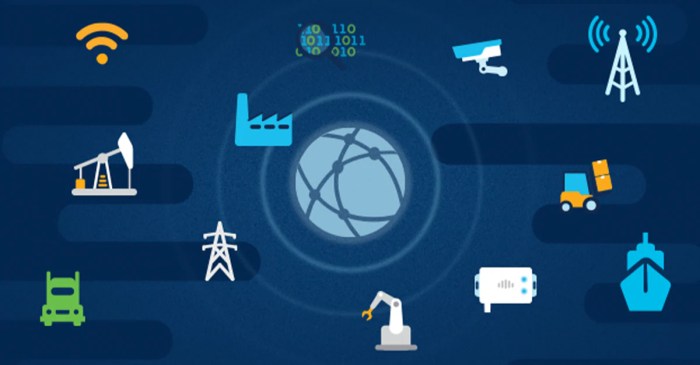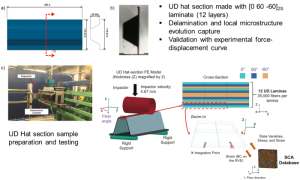
Step into the realm of Industrial IoT solutions where innovation meets efficiency, transforming industries with cutting-edge technology and seamless connectivity. Get ready to explore a world where data drives decisions and connectivity is key to success.
Let’s dive deeper into the realm of Industrial IoT solutions and unravel the mysteries behind this technological revolution.
Introduction to Industrial IoT Solutions

Industrial IoT solutions refer to the use of Internet of Things technology in industrial settings to optimize processes, increase efficiency, and improve decision-making. This technology involves connecting physical devices, machines, and sensors to the internet to collect and analyze data in real-time.
Examples of Industries Benefiting from Industrial IoT Solutions
- Manufacturing: Industrial IoT solutions are used to monitor equipment performance, predict maintenance needs, and improve overall production efficiency.
- Transportation and Logistics: IoT sensors are used to track shipments, optimize routes, and improve fleet management.
- Energy and Utilities: IoT devices help monitor energy consumption, enable smart grid systems, and improve sustainability efforts.
Importance of Connectivity and Data in Industrial IoT Solutions
Connectivity is crucial in Industrial IoT solutions as it allows devices to communicate with each other and transmit data for analysis. The data collected from various sensors and devices provides valuable insights that can be used to make informed decisions, optimize processes, and identify areas for improvement.
Benefits of Implementing Industrial IoT Solutions

Industrial IoT solutions offer a multitude of benefits to industrial settings, revolutionizing the way operations are managed and optimized. Let’s delve into the key advantages of leveraging Industrial IoT solutions and how they compare to traditional methods in terms of cost savings and efficiency improvements.
Enhanced Operational Efficiency
Industrial IoT solutions enable real-time monitoring and data analysis, allowing for proactive maintenance and optimized production processes. By collecting and analyzing data from sensors and devices, organizations can identify inefficiencies, reduce downtime, and streamline operations for maximum efficiency.
Cost Savings
Implementing Industrial IoT solutions can result in significant cost savings through predictive maintenance, energy optimization, and improved resource utilization. By detecting potential equipment failures before they occur, organizations can avoid costly downtime and reduce maintenance costs. Additionally, energy consumption can be optimized based on real-time data, leading to reduced operational expenses.
Improved Safety and Compliance
Industrial IoT solutions enhance workplace safety by providing real-time monitoring of equipment and environmental conditions. By implementing sensors and connected devices, organizations can ensure compliance with safety regulations and proactively address potential hazards. This not only safeguards employees but also minimizes the risk of costly fines and penalties for non-compliance.
Enhanced Decision-Making
With access to real-time data and analytics, decision-makers can make informed and data-driven decisions to drive business growth and operational excellence. Industrial IoT solutions provide actionable insights that enable organizations to optimize processes, identify opportunities for improvement, and stay ahead of the competition in a rapidly evolving market.
Components of Industrial IoT Solutions
Industrial IoT solutions consist of various essential components that work together to enable the monitoring, control, and optimization of industrial processes. These components play a crucial role in collecting, transmitting, analyzing, and acting upon data generated by industrial devices and equipment.
Role of Sensors
Sensors are fundamental components of Industrial IoT solutions as they are responsible for collecting data from the physical world. These devices can measure parameters such as temperature, pressure, humidity, vibration, and more. The data collected by sensors is then transmitted to the cloud for further processing and analysis.
Role of Connectivity
Connectivity is another critical component of Industrial IoT solutions as it enables seamless communication between devices, sensors, and cloud platforms. Various communication technologies such as Wi-Fi, Bluetooth, LoRa, and 5G are used to ensure reliable and secure data transfer in industrial environments.
Role of Cloud Platforms
Cloud platforms serve as the central hub for storing, processing, and analyzing the vast amounts of data generated by Industrial IoT devices. These platforms provide scalable storage, computational power, and advanced analytics capabilities to derive valuable insights and enable real-time decision-making.
Role of Data Analytics
Data analytics plays a crucial role in transforming raw data into actionable insights for optimizing industrial processes. By applying machine learning algorithms, predictive maintenance models, and anomaly detection techniques, Industrial IoT solutions can identify patterns, trends, and potential issues to improve efficiency and productivity.
Examples of Hardware and Software
Hardware
Industrial IoT solutions may include hardware components such as industrial gateways, edge computing devices, PLCs (Programmable Logic Controllers), RFID tags, and actuators.
Software
Industrial IoT solutions rely on software platforms for data visualization, dashboard creation, predictive maintenance, and remote monitoring. Examples of software tools include SCADA (Supervisory Control and Data Acquisition) systems, MES (Manufacturing Execution Systems), and IoT platforms like AWS IoT, Azure IoT, and Google Cloud IoT.
Challenges in Implementing Industrial IoT Solutions
Implementing Industrial IoT solutions in industries comes with its own set of challenges that need to be addressed for successful deployment. These challenges can range from technical issues to security concerns, impacting the efficiency and effectiveness of the IoT systems.
Security Concerns in Industrial IoT Deployments
Security is one of the primary concerns when it comes to implementing Industrial IoT solutions. The interconnected nature of IoT devices and systems makes them vulnerable to cyber attacks and data breaches. Ensuring end-to-end security, encryption of data, and implementing robust authentication mechanisms are crucial to safeguarding industrial IoT deployments.
Interoperability Issues Between Industrial IoT Devices and Systems
Interoperability is another challenge faced by industries when implementing Industrial IoT solutions. Different devices and systems from various manufacturers may not always communicate effectively with each other, leading to compatibility issues. Standardization of protocols, data formats, and communication interfaces is essential to ensure seamless interoperability between industrial IoT devices and systems.
Industrial Goods and Services
Industrial goods and services play a crucial role in the context of Industrial IoT solutions by driving efficiency, productivity, and cost-effectiveness in various industries.
Enhanced Production and Distribution
Industrial IoT solutions are revolutionizing the production and distribution of industrial goods by enabling real-time monitoring and optimization of manufacturing processes. By integrating IoT devices and sensors, manufacturers can collect and analyze data to identify inefficiencies, prevent downtime, and improve overall operational performance.
- IoT-enabled smart sensors in manufacturing equipment can provide valuable insights into equipment health and performance, allowing for predictive maintenance to be carried out proactively.
- Real-time data analytics help in optimizing production processes, reducing waste, and ensuring consistent product quality.
- Asset tracking through IoT technology enables better inventory management, streamlined supply chain operations, and timely delivery of goods to customers.
Predictive Maintenance and Asset Tracking
Predictive maintenance and asset tracking are integral components of Industrial IoT solutions that enhance the delivery of industrial services.
- Predictive maintenance utilizes data from IoT sensors to predict when equipment is likely to fail, allowing maintenance to be scheduled before issues occur. This proactive approach minimizes downtime, reduces maintenance costs, and extends the lifespan of machinery.
- Asset tracking using IoT devices provides real-time visibility into the location, status, and condition of assets throughout the supply chain. This ensures efficient utilization of resources, improved inventory management, and enhanced customer service through accurate delivery tracking.
Closing Notes
As we wrap up our journey through Industrial IoT solutions, remember that the future is bright with endless possibilities for industries to thrive in a connected world. Embrace the power of Industrial IoT solutions and watch as your business reaches new heights of success.
Question Bank
How do Industrial IoT solutions benefit different industries?
Industrial IoT solutions enhance efficiency, reduce downtime, and optimize processes across various industries like manufacturing, healthcare, and logistics.
What are some common challenges faced in implementing Industrial IoT solutions?
Common challenges include security concerns, interoperability issues between devices, and the need for skilled personnel to manage IoT systems effectively.
What role do sensors play in Industrial IoT solutions?
Sensors collect data from physical assets and environments, enabling real-time monitoring, predictive maintenance, and data-driven decision-making in industrial settings.





